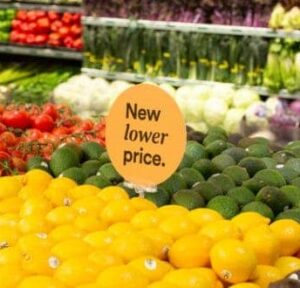 In retail grocery, I think so; in food processing, I’m unsure.
In retail grocery, I think so; in food processing, I’m unsure.
Employers in the food industry are paying higher wages, retailers are passing along price increases by distributors and processers, and all have higher costs. Thus, some price increases are unavoidable.
The question is whether companies are using inflation as cover to raise prices more than their costs, to fatten profits at consumers’ expense.
First, the anecdotal evidence: When grocery shopping now, I’m seeing some food prices reverting close to what they were before. This suggests those prices were raised more than necessary and competition is forcing them back down.
Now for hard data. I picked a couple of examples. Kroger is America’s largest grocery retailer; here in Washington, they own the Fred Meyer and QFC stores. Kroger is publicly traded, so their financials can be looked up (I’m using Value Line for this purpose).
Before we look at those numbers, keep in mind the pandemic shut down restaurants, making people eat at home more. So, you expect to see grocery store sales increase beginning in 2020. With that in mind, let’s look at Kroger’s data.
Sales
In 2018 and 2019, annual sales were ~$122 billion; this increased to $132 billion in 2020, $138 billion in 2021, $148 billion in 2022, and $150 billion in 2023, while the number of stores declined slightly.
Profits
Net profit jumped from $1.7 billion in 2018 and 2019 to $2.7 billion in 2020, $2.8 billion in 2021, $3.1 billion in 2022, and nearly $3.5 billion in 2023, but is projected to fall back to $3.2 billion in 2024 and 2025. While some of this is attributable to higher sales, some is not; let’s look at profit margins next.
Profit Margins
From 2017 to 2019, the profit margin was around 1.5%; then in 2020, it ballooned to over 2.1% and has stayed there.
So, does it look like Kroger has been price-gouging since the pandemic began? It sure does, at least to me, although it began well before inflation took off in 2022, so Kroger’s profit-fattening correlates more tightly with the pandemic than inflation.
Now lets look at ConAgra, a food processor that owns popular brands like Armour and Hebrew National meats, Birds Eye frozen vegetables, Chef Boyardee products, and Banquet, Healthy Choice, Hungry Man, and Marie Callender’s frozen meals, plus many others (see list here).
Sales
Like Kroger, ConAgra experienced a sales jump when the pandemic shuttered restaurants. Their sales went from $7.9 billion in 2018 and $9.5 billion in 2019 to over $11 billion in 2020, climbing to over $12 billion by 2023.
Profits
ConAgra, too, experienced a profit jump coinciding with the pandemic: From under $900 million in 2018 and 2019 to over $1.1 beginning in 2020 rising to $1.3 billion by 2023.
Profit Margins
ConAgra’s profit margin was under 6% before 2016, rose 10% by 2018, and stayed there but didn’t rise further.
ConAgra did not reap wider profit margins from the pandemic or the inflation that followed, so based on the limited and unscientific sample of these two companies, it appears the price-gouging was at the retail level. This also explains why we haven’t really seen much grocery “shrinkflation” (see story here), because retailers can’t make cans and packages smaller.
Grocery shoppers don’t crunch numbers like I just did, but they know when they’re paying more, and sense when they’re being ripped off. And because customers react to price increases, stores try to deflect blame to inflation and crime (e.g. more shoplifting).
Those are real issues, but their impact has been exaggerated to cover for price hikes going straight to the profit line. Because retail grocery is a competitive industry, some of those higher prices won’t stick, and shoppers will be seeing more sales and discounts.